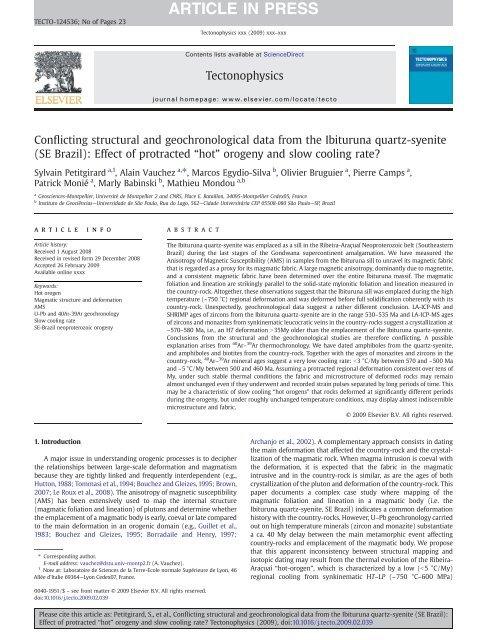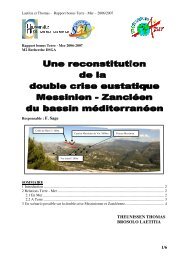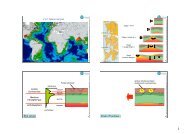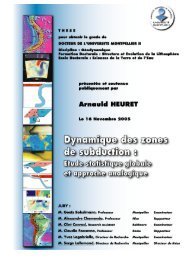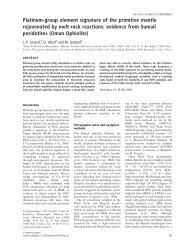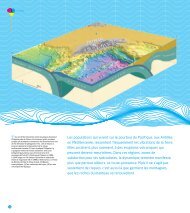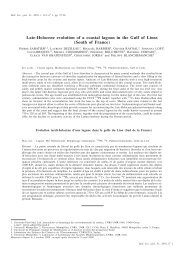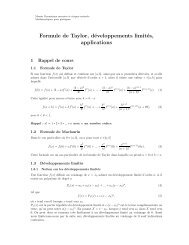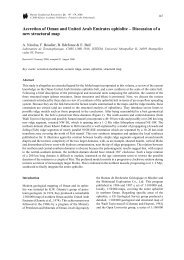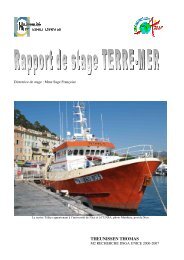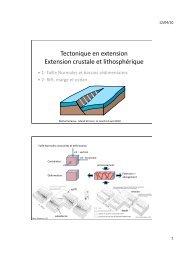Géochronologie U-Pb par ablation laser et ICP-MS (LA-ICP-MS ...
Géochronologie U-Pb par ablation laser et ICP-MS (LA-ICP-MS ...
Géochronologie U-Pb par ablation laser et ICP-MS (LA-ICP-MS ...
Create successful ePaper yourself
Turn your PDF publications into a flip-book with our unique Google optimized e-Paper software.
TECTO-124536; No of Pages 23<br />
ARTICLE IN PRESS<br />
Tectonophysics xxx (2009) xxx–xxx<br />
Contents lists available at ScienceDirect<br />
Tectonophysics<br />
journal homepage: www.elsevier.com/locate/tecto<br />
Conflicting structural and geochronological data from the Ibituruna quartz-syenite<br />
(SE Brazil): Effect of protracted “hot” orogeny and slow cooling rate<br />
Sylvain P<strong>et</strong>itgirard a,1 , Alain Vauchez a, ⁎, Marcos Egydio-Silva b , Olivier Bruguier a , Pierre Camps a ,<br />
Patrick Monié a , Marly Babinski b , Mathieu Mondou a,b<br />
a Geosciences-Montpellier, Université de Montpellier 2 and CNRS, Place E. Bataillon, 34095-Montpellier Cedex05, France<br />
b Instituto de Geociências—Universidade de São Paulo, Rua do Lago, 562—Cidade Universitária CEP 05508-080 São Paulo—SP, Brazil<br />
article<br />
info<br />
abstract<br />
Article history:<br />
Received 1 August 2008<br />
Received in revised form 29 December 2008<br />
Accepted 26 February 2009<br />
Available online xxxx<br />
Keywords:<br />
Hot orogen<br />
Magmatic structure and deformation<br />
A<strong>MS</strong><br />
U-<strong>Pb</strong> and 40Ar-39Ar geochronology<br />
Slow cooling rate<br />
SE-Brazil neoproterozoic orogeny<br />
The Ibituruna quartz-syenite was emplaced as a sill in the Ribeira-Araçuaí Neoproterozoic belt (Southeastern<br />
Brazil) during the last stages of the Gondwana supercontinent amalgamation. We have measured the<br />
Anisotropy of Magn<strong>et</strong>ic Susceptibility (A<strong>MS</strong>) in samples from the Ibituruna sill to unravel its magn<strong>et</strong>ic fabric<br />
that is regarded as a proxy for its magmatic fabric. A large magn<strong>et</strong>ic anisotropy, dominantly due to magn<strong>et</strong>ite,<br />
and a consistent magn<strong>et</strong>ic fabric have been d<strong>et</strong>ermined over the entire Ibituruna massif. The magmatic<br />
foliation and lineation are strikingly <strong>par</strong>allel to the solid-state mylonitic foliation and lineation measured in<br />
the country-rock. Altog<strong>et</strong>her, these observations suggest that the Ibituruna sill was emplaced during the high<br />
temperature (~750 °C) regional deformation and was deformed before full solidification coherently with its<br />
country-rock. Unexpectedly, geochronological data suggest a rather different conclusion. <strong>LA</strong>-<strong>ICP</strong>-<strong>MS</strong> and<br />
SHRIMP ages of zircons from the Ibituruna quartz-syenite are in the range 530–535 Ma and <strong>LA</strong>-<strong>ICP</strong>-<strong>MS</strong> ages<br />
of zircons and monazites from synkinematic leucocratic veins in the country-rocks suggest a crystallization at<br />
~570–580 Ma, i.e., an HT deformation N35My older than the emplacement of the Ibituruna quartz-syenite.<br />
Conclusions from the structural and the geochronological studies are therefore conflicting. A possible<br />
explanation arises from 40 Ar– 39 Ar thermochronology. We have dated amphiboles from the quartz-syenite,<br />
and amphiboles and biotites from the country-rock. Tog<strong>et</strong>her with the ages of monazites and zircons in the<br />
country-rock, 40 Ar– 39 Ar mineral ages suggest a very low cooling rate: b3 °C/My b<strong>et</strong>ween 570 and ~500 Ma<br />
and ~5 °C/My b<strong>et</strong>ween 500 and 460 Ma. Assuming a protracted regional deformation consistent over tens of<br />
My, under such stable thermal conditions the fabric and microstructure of deformed rocks may remain<br />
almost unchanged even if they underwent and recorded strain pulses se<strong>par</strong>ated by long periods of time. This<br />
may be a characteristic of slow cooling “hot orogens” that rocks deformed at significantly different periods<br />
during the orogeny, but under roughly unchanged temperature conditions, may display almost indiscernible<br />
microstructure and fabric.<br />
© 2009 Elsevier B.V. All rights reserved.<br />
1. Introduction<br />
A major issue in understanding orogenic processes is to decipher<br />
the relationships b<strong>et</strong>ween large-scale deformation and magmatism<br />
because they are tightly linked and frequently interdependent (e.g.,<br />
Hutton, 1988; Tommasi <strong>et</strong> al., 1994; Bouchez and Gleizes, 1995; Brown,<br />
2007; Le Roux <strong>et</strong> al., 2008). The anisotropy of magn<strong>et</strong>ic susceptibility<br />
(A<strong>MS</strong>) has been extensively used to map the internal structure<br />
(magmatic foliation and lineation) of plutons and d<strong>et</strong>ermine wh<strong>et</strong>her<br />
the emplacement of a magmatic body is early, coeval or late com<strong>par</strong>ed<br />
to the main deformation in an orogenic domain (e.g., Guill<strong>et</strong> <strong>et</strong> al.,<br />
1983; Bouchez and Gleizes, 1995; Borradaile and Henry, 1997;<br />
⁎ Corresponding author.<br />
E-mail address: vauchez@dstu.univ-montp2.fr (A. Vauchez).<br />
1 Now at: Laboratoire de Sciences de la Terre-Ecole normale Supérieure de Lyon, 46<br />
Allée d'Italie 69364—Lyon Cedex07, France.<br />
Archanjo <strong>et</strong> al., 2002). A complementary approach consists in dating<br />
the main deformation that affected the country-rock and the crystallization<br />
of the magmatic rock. When magma intrusion is coeval with<br />
the deformation, it is expected that the fabric in the magmatic<br />
intrusive and in the country-rock is similar, as are the ages of both<br />
crystallization of the pluton and deformation of the country-rock. This<br />
paper documents a complex case study where mapping of the<br />
magmatic foliation and lineation in a magmatic body (i.e. the<br />
Ibituruna quartz-syenite, SE Brazil) indicates a common deformation<br />
history with the country-rocks. However, U–<strong>Pb</strong> geochronology carried<br />
out on high temperature minerals (zircon and monazite) substantiate<br />
a ca. 40 My delay b<strong>et</strong>ween the main m<strong>et</strong>amorphic event affecting<br />
country-rocks and emplacement of the magmatic body. We propose<br />
that this ap<strong>par</strong>ent inconsistency b<strong>et</strong>ween structural mapping and<br />
isotopic dating may result from the thermal evolution of the Ribeira-<br />
Araçuaí “hot-orogen”, which is characterized by a low (b5 °C/My)<br />
regional cooling from synkinematic HT–LP (~750 °C–600 MPa)<br />
0040-1951/$ – see front matter © 2009 Elsevier B.V. All rights reserved.<br />
doi:10.1016/j.tecto.2009.02.039<br />
Please cite this article as: P<strong>et</strong>itgirard, S., <strong>et</strong> al., Conflicting structural and geochronological data from the Ibituruna quartz-syenite (SE Brazil):<br />
Effect of protracted “hot” orogeny and slow cooling rate Tectonophysics (2009), doi:10.1016/j.tecto.2009.02.039


